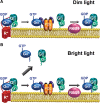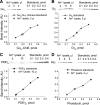Mechanistic basis for the failure of cone transducin to translocate: why cones are never blinded by light
- PMID: 20484624
- PMCID: PMC2883257
- DOI: 10.1523/JNEUROSCI.0613-10.2010
Mechanistic basis for the failure of cone transducin to translocate: why cones are never blinded by light
Abstract
The remarkable ability of our vision to function under ever-changing conditions of ambient illumination is mediated by multiple molecular mechanisms regulating the light sensitivity of rods and cones. One such mechanism involves massive translocation of signaling proteins, including the G-protein transducin, into and out of the light-sensitive photoreceptor outer segment compartment. Transducin translocation extends the operating range of rods, but in cones transducin never translocates, which is puzzling because cones typically function in much brighter light than rods. Using genetically manipulated mice in which the rates of transducin activation and inactivation were altered, we demonstrate that, like in rods, transducin translocation in cones can be triggered when transducin activation exceeds a critical level, essentially saturating the photoresponse. However, this level is never achieved in wild-type cones: their superior ability to tightly control the rates of transducin activation and inactivation, responsible for avoiding saturation by light, also accounts for the prevention of transducin translocation at any light intensity.
Figures







References
-
- Anant JS, Ong OC, Xie HY, Clarke S, O'Brien PJ, Fung BK. In vivo differential prenylation of retinal cyclic GMP phosphodiesterase catalytic subunits. J Biol Chem. 1992;267:687–690. - PubMed
-
- Arshavsky VY. Rhodopsin phosphorylation: from terminating single photon responses to photoreceptor dark adaptation. Trends Neurosci. 2002;25:124–126. - PubMed
-
- Arshavsky VY, Lamb TD, Pugh EN., Jr G proteins and phototransduction. Annu Rev Physiol. 2002;64:153–187. - PubMed
-
- Artemyev NO. Light-dependent compartmentalization of transducin in rod photoreceptors. Mol Neurobiol. 2008;37:44–51. - PubMed
Publication types
MeSH terms
Substances
Grants and funding
- EY08571/EY/NEI NIH HHS/United States
- EY5722/EY/NEI NIH HHS/United States
- EY13729/EY/NEI NIH HHS/United States
- P30 EY005722/EY/NEI NIH HHS/United States
- R01 EY010336/EY/NEI NIH HHS/United States
- EY11123/EY/NEI NIH HHS/United States
- U10 EY013729/EY/NEI NIH HHS/United States
- EY072224/EY/NEI NIH HHS/United States
- P30 EY008571/EY/NEI NIH HHS/United States
- EY10336/EY/NEI NIH HHS/United States
- R01 EY011123/EY/NEI NIH HHS/United States
- P30 EY021721/EY/NEI NIH HHS/United States
- R01 EY012224/EY/NEI NIH HHS/United States
LinkOut - more resources
Full Text Sources
Molecular Biology Databases
